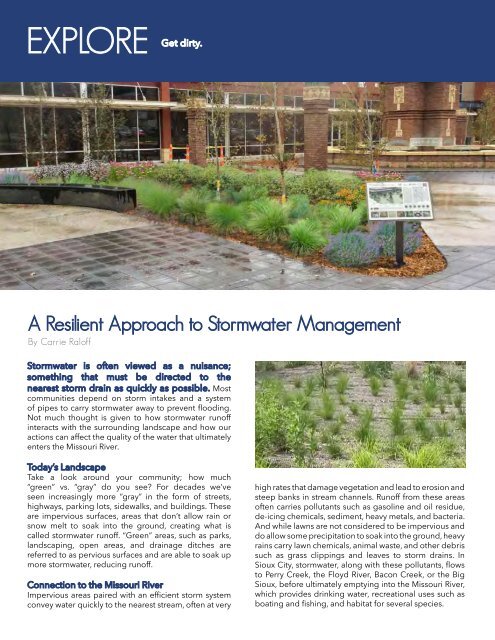Siouxland Magazine - Volume 1 Issue 4
Create successful ePaper yourself
Turn your PDF publications into a flip-book with our unique Google optimized e-Paper software.
explore<br />
Get dirty.<br />
A Resilient Approach to Stormwater Management<br />
By Carrie Raloff<br />
Stormwater is often viewed as a nuisance;<br />
something that must be directed to the<br />
nearest storm drain as quickly as possible. Most<br />
communities depend on storm intakes and a system<br />
of pipes to carry stormwater away to prevent flooding.<br />
Not much thought is given to how stormwater runoff<br />
interacts with the surrounding landscape and how our<br />
actions can affect the quality of the water that ultimately<br />
enters the Missouri River.<br />
Today’s Landscape<br />
Take a look around your community; how much<br />
“green” vs. “gray” do you see? For decades we’ve<br />
seen increasingly more “gray” in the form of streets,<br />
highways, parking lots, sidewalks, and buildings. These<br />
are impervious surfaces, areas that don’t allow rain or<br />
snow melt to soak into the ground, creating what is<br />
called stormwater runoff. “Green” areas, such as parks,<br />
landscaping, open areas, and drainage ditches are<br />
referred to as pervious surfaces and are able to soak up<br />
more stormwater, reducing runoff.<br />
Connection to the Missouri River<br />
Impervious areas paired with an efficient storm system<br />
convey water quickly to the nearest stream, often at very<br />
high rates that damage vegetation and lead to erosion and<br />
steep banks in stream channels. Runoff from these areas<br />
often carries pollutants such as gasoline and oil residue,<br />
de-icing chemicals, sediment, heavy metals, and bacteria.<br />
And while lawns are not considered to be impervious and<br />
do allow some precipitation to soak into the ground, heavy<br />
rains carry lawn chemicals, animal waste, and other debris<br />
such as grass clippings and leaves to storm drains. In<br />
Sioux City, stormwater, along with these pollutants, flows<br />
to Perry Creek, the Floyd River, Bacon Creek, or the Big<br />
Sioux, before ultimately emptying into the Missouri River,<br />
which provides drinking water, recreational uses such as<br />
boating and fishing, and habitat for several species.


















